Barrio Simón Bolívar
Barranquilla, Colombia
1955–1956
The neighborhood known today as Simón Bolívar was built in the mid 1950s in the port city of Barranquilla, along the Caribbean coast of Colombia. The project resulted in part from an extensive campaign of investment led by President Rojas Pinilla. The existing ‘Las Nieves’ airport was relocated to the periphery of the city, making space for a new housing area that would accommodate thousands of working-class families. As part of this effort, a trade deal was signed in 1955 that required 2,700 wooden houses from Finland in exchange for $3 million of Colombian coffee. The deal was facilitated through a strategic reduction of tariffs on both products implemented by each national government, and it quickly made Colombia the most important export destination for Finnish wooden houses in Latin America.
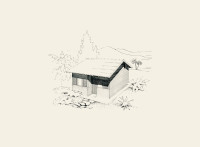
Kaarlo Humanisto’s perspective drawing depicts a model 1641 in an imaginary Colombian landscape. Image © ELKA
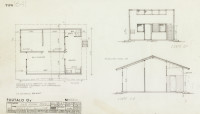
The 40m2 house had three rooms and a covered porch with a kitchen and a toilet. Image © ELKA
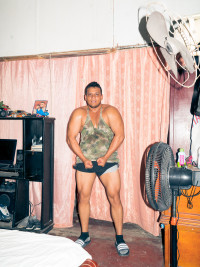
Although they were constructed as detached houses, many homes in the neighborhood have been expanded with living or working spaces.
Rolando uses the adjoining space as an office for his business selling nutritional supplements.
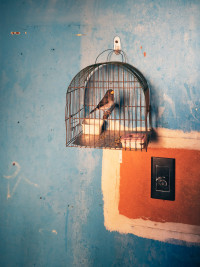
A caged bird hangs on the wall of a house in Simon Bolivar. During construction, many locals were skeptical of the wooden houses and called them pigeon coops (palomares).
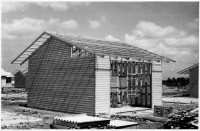
A house sits waiting for asbestos cement roofing to be installed. Photo © ELKA
Most buildings were sent to the cities of Cartagena and Barranquilla, with Simón Bolívar as the largest single site. All houses were of the 40 m2 type E-1641, designed in accordance with drawings provided by the Colombian client, Instituto de Credito Territorial. To minimize volume (and cost) during transport, the structures were built from pre-cut lumber instead of the prefabricated panels used in most other deliveries. The tropical climate demanded wide eaves for sun protection, and special attention was given to ventilation. The pine wood elements were impregnated with an insect repellent, but the Colombians reported that the kitchens of numerous houses, which had been built with less-resistant birch panels, were damaged by termites. The client insisted that Puutalo take responsibility for the repairs, a debate which led to extensive negotiations between both parties.
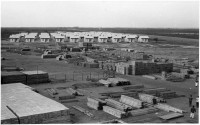
Stacks of pre-cut material stand ready and waiting for assembly at the former airport. Photo © ELKA
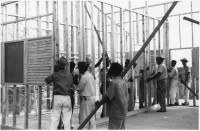
Instead of prefabricated panels, the walls of houses exported to Colombia were assembled from pre-cut timber components. Photo © ELKA
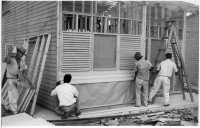
Workers install exterior cladding on top of building paper. Due to the tropical climate, the windows were fitted with wooden louvres and insect screens instead of glazing. Photo © ELKA
Today, the neighborhood has become dramatically denser, especially along the main boulevard. Most houses have been replaced by larger structures of concrete and masonry, but distinctive wooden façades can be found along many blocks. Most of these remaining buildings have been extended to provide space for living and working. At the same time, new dwellings have been built in concrete according to similar plans. Occasionally, wooden doors and windows salvaged from the wooden houses can be seen on these newer structures. The area maintains a strong identity as a vibrant, working-class community and many of the homes are still occupied by descendants of the original owners.
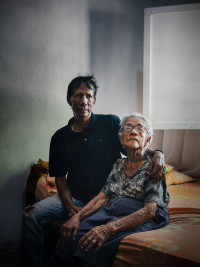
Olga moved into her home in 1957 and raised nine children there with her husband. Her son, Nelson, was born in this room in 1964 and has lived in the house ever since. Today he cares for his mother with the help of his brother, wife and son.
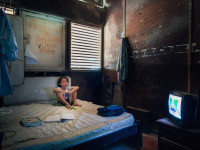
Due to the tropical Caribbean climate, the houses were built with special attention to shading and ventilation. Louvered panels modulate both light and sound between the street outside and the interior of each home.
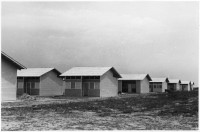
A row of completed houses. Photo © ELKA
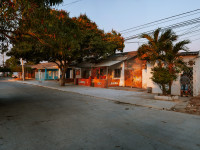
Today it can be difficult to identify wooden houses in the neighborhood as repairs, expansion and alterations have made many of them nearly unrecognizable. However, the distinct roof shape and horizontal cladding boards are often visible on the gabled walls of the side façades.
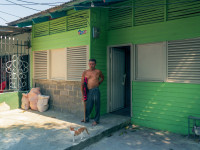
Augusto moved into his house in 1963 and grew up there with his mother, father and 9 siblings. Today he shares the home with his brother and two children.
